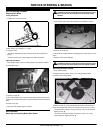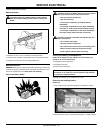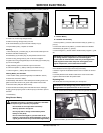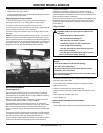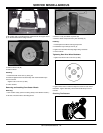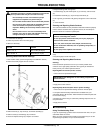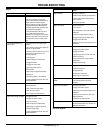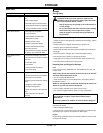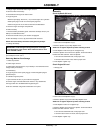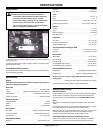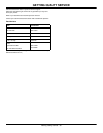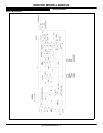
Troubleshooting - 30
TROUBLESHOOTING
1.1. Check tires for damage.
2. Check tire pressure with an accurate gauge.
3. Add air, if necessary:
c
Servicing Caster Wheel Roller Bearings
1. Park machine safely. (See Parking Safely in the SAFETY section.)
2. Raise and securely support front of machine.
c
3. Remove locknut (A), cap screw (B), and wheel assembly (C).
4. Remove seals (D) and bearings (E) from wheel.
5. Clean and inspect bearings (E). Replace as needed.
6. Repack bearings with clean grease.
7. Install bearings (E) and wheel spacer (F) (if removed), and new seals
(D).
8. Install wheel assembly (C), cap screw (B) and locknut (A).
9. Use a grease gun to fill hub until grease just appears at one of the seals
(D).
10. Lower machine.
Cleaning and Repairing Plastic Surfaces
Your authorized dealer has the professional materials needed to properly
remove surface scratches from any plastic surfaces, do not attempt to
paint over marks or scratches in plastic parts.
c
1. Wash surface with clean water and a mild liquid automotive washing
soap.
2. Dry thoroughly to avoid water spots.
Cleaning and Repairing Metal Surfaces
Cleaning:
Follow automotive practices to care for your vehicle painted metal
surfaces. Use a high-quality automotive wax regularly to maintain the
factory look of your vehicle’s painted surfaces.
Repairing Minor Scratches (surface scratch):
1. Clean area to be repaired thoroughly.
c
2. Use automotive polishing compound to remove surface scratches.
3. Apply wax to entire surface.
Repairing Deep Scratches (bare metal or primer showing):
1. Clean area to be repaired with rubbing alcohol or mineral spirits.
2. Use paint stick with factory-matched colors available from your
authorized dealer to fill scratches. Follow directions included on paint stick
for use and for drying.
3. Smooth out surface using an automotive polishing compound. Do not
use power buffer.
4. Apply wax to surface.
Troubleshooting
Using Troubleshooting Chart
If you are experiencing a problem that is not listed in this chart, see your
authorized dealer for service.
When you have checked all the possible causes listed and you are still
experiencing the problem, see your authorized dealer.
CAUTION: Avoid injury! Explosive separation of tire and rim
parts is possible when they are serviced incorrectly:
Do not attempt to mount a tire without the proper
equipment and experience to perform the job.
Do not inflate the tires above the recommended pressure.
Do not weld or heat a wheel and tire assembly. Heat can
cause an increase in air pressure resulting in an
explosion. Welding can structurally weaken or deform the
wheel.
Do not stand in front or over the tire assembly when
inflating. Use a clip-on chuck and extension hose long
enough to allow you to stand to one side.
Tire Size Pressure
Front: 11 x 4 - 5 138–173 kPa (20-25 psi)
Rear: 18 x 8.5 - 8 69–97 kPa (10–14 psi)
IMPORTANT: Avoid Damage! Improper care of machine plastic
surfaces can damage that surface:
Do not wipe plastic surfaces when they are dry. Dry wiping will
result in minor surface scratches.
Use a soft, clean cloth (bath towel, diaper, automotive mitt).
Do not use abrasive materials, such as polishing compounds, on
plastic surfaces.
Do not spray insect repellent near machine.
IMPORTANT: Avoid damage! Do not use rubbing compound on
painted surfaces.




